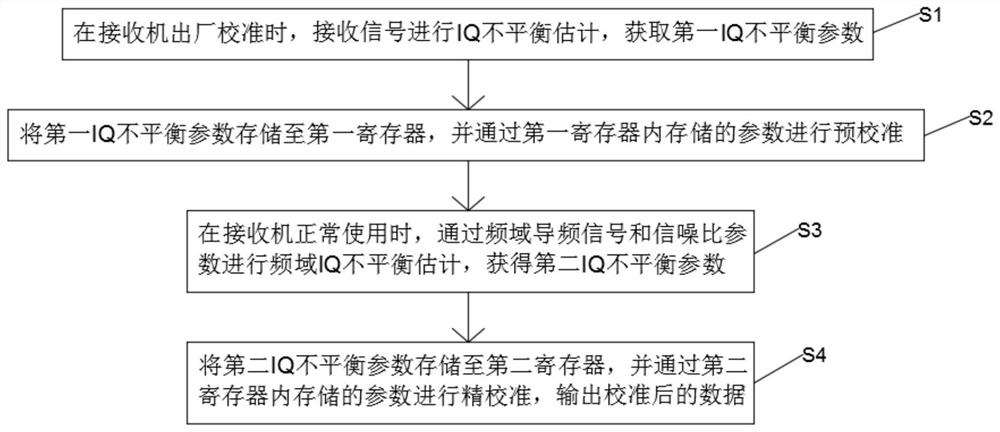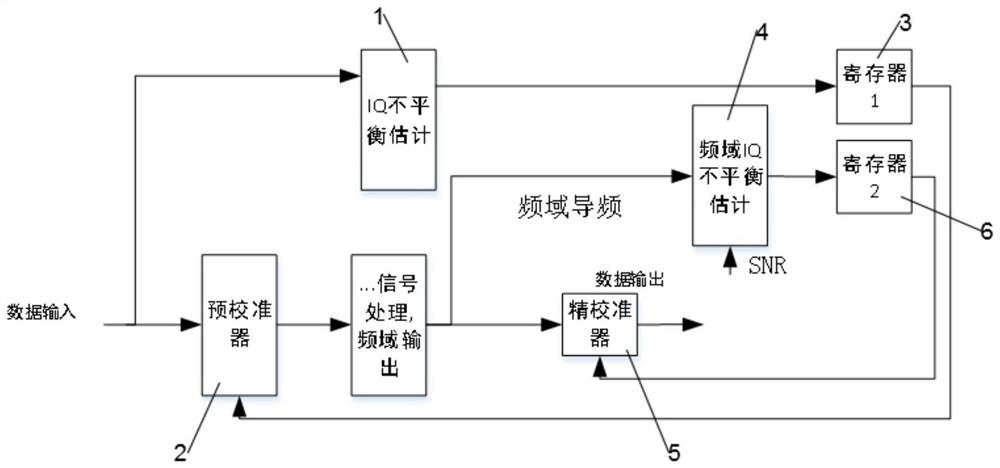IQ imbalance correction method and system of zero intermediate frequency receiver
A zero-IF receiver and balanced correction technology, which is applied in the transmission system, multi-carrier system, digital transmission system, etc., can solve the problems of low correction accuracy, imbalance, and reduce the bit error performance of the receiving system, and achieve high correction accuracy Effect
- Summary
- Abstract
- Description
- Claims
- Application Information
AI Technical Summary
Problems solved by technology
Method used
Image
Examples
Embodiment 1
[0067] An embodiment of the present invention, such as figure 1 As shown, the present invention provides a method for correcting IQ imbalance of a zero-IF receiver, comprising steps:
[0068] S1. When the receiver is calibrated at the factory, perform IQ imbalance estimation on the received signal, and obtain a first IQ imbalance parameter.
[0069] S2. Store the first IQ imbalance parameter in the first register, and perform pre-calibration according to the parameter stored in the first register.
[0070] S3. When the receiver is in normal use, perform frequency-domain IQ imbalance estimation by using the frequency-domain pilot signal and the signal-to-noise ratio parameter to obtain a second IQ imbalance parameter.
[0071] S4. Store the second IQ imbalance parameter in the second register, perform fine calibration with the parameters stored in the second register, and output the calibrated data.
[0072] This solution obtains the first IQ imbalance parameter by performing...
Embodiment 2
[0074] In one embodiment of the present invention, on the basis of Embodiment 1, when the receiver is calibrated at the factory, the IQ imbalance estimation is performed on the received signal, and the first IQ imbalance parameter is obtained, which specifically includes:
[0075] S11. When the receiver is calibrated at the factory, it is initially powered on, and a single-tone signal is generated by the signal transmitting source and input to the receiver.
[0076] S12. Receive a signal, and calculate several first imbalance parameters within a predetermined period.
[0077] Specifically, such as image 3 As shown, the para_len imbalance parameters a_I, a_Q and alpha are calculated with data_length as the cycle, a_I is the amplitude gain of the I channel, a_Q is the amplitude gain of the Q channel, and alpha is the phase imbalance parameter of the IQ two channels, and data_length and para_len are predefined The variables of can be adjusted according to the actual scene, wher...
Embodiment 3
[0089] In one embodiment of the present invention, on the basis of embodiment 1 or embodiment 2, when the receiver is in normal use, the frequency domain IQ imbalance is estimated through the frequency domain pilot signal and the signal-to-noise ratio parameter, and the second IQ imbalance is obtained. Balance parameters, including:
[0090] S31. Process the pre-calibrated signal to obtain a frequency-domain pilot signal, and initialize imbalance parameters b_I=1 (signal gain) and b_Q=0 (image gain) for frequency-domain IQ imbalance estimation.
[0091] S32. Determine whether to perform fine frequency domain calibration according to the signal-to-noise ratio parameter of the frequency domain pilot signal.
[0092] S33. When the judgment is yes, perform frequency-domain IQ imbalance estimation by using the frequency-domain pilot signal and the signal-to-noise ratio parameter, and obtain several second imbalance parameters.
[0093] S34. Average several second imbalance paramet...
PUM
 Login to View More
Login to View More Abstract
Description
Claims
Application Information
 Login to View More
Login to View More - R&D
- Intellectual Property
- Life Sciences
- Materials
- Tech Scout
- Unparalleled Data Quality
- Higher Quality Content
- 60% Fewer Hallucinations
Browse by: Latest US Patents, China's latest patents, Technical Efficacy Thesaurus, Application Domain, Technology Topic, Popular Technical Reports.
© 2025 PatSnap. All rights reserved.Legal|Privacy policy|Modern Slavery Act Transparency Statement|Sitemap|About US| Contact US: help@patsnap.com



